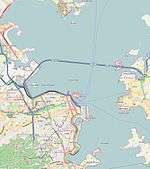Rio–Niterói Bridge
| Rio-Niterói Bridge | |
|---|---|
 | |
| Coordinates | 22°52′16″S 43°09′12″W / 22.871213°S 43.153406°WCoordinates: 22°52′16″S 43°09′12″W / 22.871213°S 43.153406°W |
| Carries | 8 lanes of BR-101 |
| Crosses | Guanabara Bay |
| Locale | Rio de Janeiro and Niterói, Brazil |
| Official name | President Costa e Silva Bridge |
| Characteristics | |
| Design | Box girder bridge |
| Total length | 13,290 m (8.25 miles) |
| Width | 27 m (88.58 ft) |
| Longest span | 300 m |
| History | |
| Construction begin | August 23, 1968 |
| Opened | March 4, 1974 |
| Statistics | |
| Daily traffic | 140,000 |
| Toll | Yes |
President Costa e Silva Bridge, commonly known as the Rio-Niterói Bridge, is a box girder bridge crossing Guanabara Bay, in the State of Rio de Janeiro in Brazil. It connects the cities of Rio de Janeiro and Niterói. It is currently the longest prestressed concrete bridge in the southern hemisphere, and the sixth longest in the world. From its completion in 1974 until 1985 it was the world's second-longest bridge, second only to Lake Pontchartrain Causeway.
History

The concept of its design dates back to 1875. In order to connect the two neighbouring towns, separated by the Guanabara Bay or an inland journey of more than 100 kilometers (62 mi), passing through the city of Magé. At the time it was intended to build a bridge and subsequently a tunnel.
In 1963 a working group was created to study a bridge-building project. On 29 December 1965 an executive committee was formed to take care of the final project of building a bridge.
President Artur da Costa e Silva signed a decree on 23 August 23 1968 Authorizing the project for the bridge, designed by Mario Andreazza the Minister of Transport, under the management of whom the bridge was begun and completed.
Construction began symbolically on 23 August 1968 in the presence of Queen Elizabeth II of the United Kingdom and Prince Philip, Duke of Edinburgh alongside Mario Andreazza in on their first, and thus far only, visit to Brazil. Actual work began in January 1969 and it opened on 4 March 1974.
Its official name is the President Costa e Silva Bridge, in honour of the president who ordered its construction. "Rio-Niterói" started as a descriptive nickname that soon became better known than the official name. Today hardly anyone refers to it by its official name.
The bridge was constructed by Cleveland Bridge & Engineering Company and Redpath Dorman Long.[1] It is 13.290 kilometres (8.258 mi) long – 8.836 kilometres (5.490 mi) over water and the bridge's 300-metre (980 ft) central span is 72 metres (236 ft) high in order to allow the passage of hundreds of ships entering and leaving the bay every month. At the time it was completed, the central span was the longest box girder in the world;[2] it has since been surpassed by the 301-metre (988 ft) main span of the Stolma Bridge (1998) and the 330-metre (1,080 ft) main span of the second Shibanpo Bridge (2006).[3] It carries 140,000 vehicles daily, which pay a toll only when entering Niterói of R$5.50 (as of September 2014), about US$2.50 or €1.90. It has 18 access points and eight overpasses.
Officially it is part of federal highway BR-101. From 1 June 1995 it was under the management of Ponte S.A. under a 20-year concession until 1 June 2015 since when Ecoponte has managed the bridge.
In 1977, famous Brazilian singer Maysa died in a car crash on the bridge.[4]
The bridge was featured in the 2011 film, Fast Five. The Puerto Rican bridge, Teodoro Moscoso, doubled for the bridge during the last moments of the film. Gal Gadot rode over this bridge on a bike in Fast Five.
In 2012 a bill was introduced to change its official name, President Costa e Silva Bridge - the second president of the Brazilian military dictatorship between 1964 and 1985 - to Herbert de Souza Bridge, which has annoyed the Brazilian military.[5]


Gallery
References
- ↑ "Heritage project reveals unique Rio bridge pics". Teesside University. 13 June 2014. Retrieved 20 October 2016.
- ↑ de Vasconcelos, Augusto Carlos; Marchesini, Gilson L.; Timerman, Júlio (2014). "4.4 Steel Box Bridges". In Chen, Wai-Fah; Duan, Lian. Handbook of International Bridge Engineering. Boca Raton, Florida: CRC Press. p. 184–186. ISBN 978-1-4398-1029-3. Retrieved 26 July 2015.
- ↑ "Shibanpo Bridge Breaks World Record for Longest Box Girder Bridge Span". Segments. American Segmental Bridge Institute. 48. Fall 2006. Retrieved 26 July 2015.
- ↑ All Music
- ↑ Possível mudança de nome da Ponte Rio-Niterói irrita militares
External links
- Official website with live feed from the bridge's surveillance cameras: Ponte S.A. homepage
- Satellite picture by Google Maps
- Photo Gallery driving over the bridge
| Wikimedia Commons has media related to Rio-Niterói Bridge. |



_near_the_Rio-Niteroi_bridge_during_the_ship's_first_foreign_port_visit.jpg)

